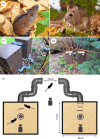Catch me if you can: free-living mice show a highly flexible dodging behaviour suggestive of intentional tactical deception
- PMID: 39253095
- PMCID: PMC11382684
- DOI: 10.1098/rsos.231692
Catch me if you can: free-living mice show a highly flexible dodging behaviour suggestive of intentional tactical deception
Abstract
Intentional tactical deception, the employment of a tactic to intentionally deceive another animal, is a complex behaviour based on higher-order cognition, that has rarely been documented outside of primates and corvids. New laboratory-to-field assays, however, provide the opportunity to investigate such behaviour among free-living mice. In the present study, we placed laboratory-style test chambers with a single entrance near a forest outside Warsaw, where we observed the social interactions of two territorial murids, black-striped and yellow-necked mice, under food competition for seven months. Notably, among the social interactions, we video-recorded 21 instances of deceptive pursuer evasion. In the most obvious cases, an individual inside the chamber, to avoid an incoming mouse, hid by the chamber opening (the only means to enter or exit), paused until the pursuer entered and passed by, and then exploited the distraction of the back-turned pursuer by fleeing through the opening in a direction opposite to the one the pursuer came from. This deceptive dodging is the first evidence of a behaviour suggestive of intentional tactical deception among mice. As such, this deceptive behaviour may be of interest not only for rodent psychology but also, more generally, for the fields of non-human intentionality and theory of mind.
Keywords: Apodemus agrarius; cognition; cognitive ethology; intentionality; naturalistic behavioral studies; tactical deception.
© 2024 The Authors.
Conflict of interest statement
We declare we have no competing interests.
Figures





References
-
- Dwużnik D, Gortat T, Behnke JM, Gryczyńska A, Bednarska M, Mikoszewski AS, Kozakiewicz M, Bajer A. 2017. Comparison of helminth community of Apodemus agrarius and Apodemus flavicollis between urban and suburban populations of mice. Parasitol. Res. 116, 2995–3006. (10.1007/s00436-017-5609-5) - DOI - PMC - PubMed
-
- Caro T. 2014. Antipredator deception in terrestrial vertebrates. Curr. Zool. 60, 16–25. (10.1093/czoolo/60.1.16) - DOI
-
- Šekrst K. 2022. Everybody lies: deception levels in various domains of life. Biosemiotics 15, 309–324. (10.1007/s12304-022-09485-9) - DOI
Associated data
LinkOut - more resources
Full Text Sources
Research Materials

